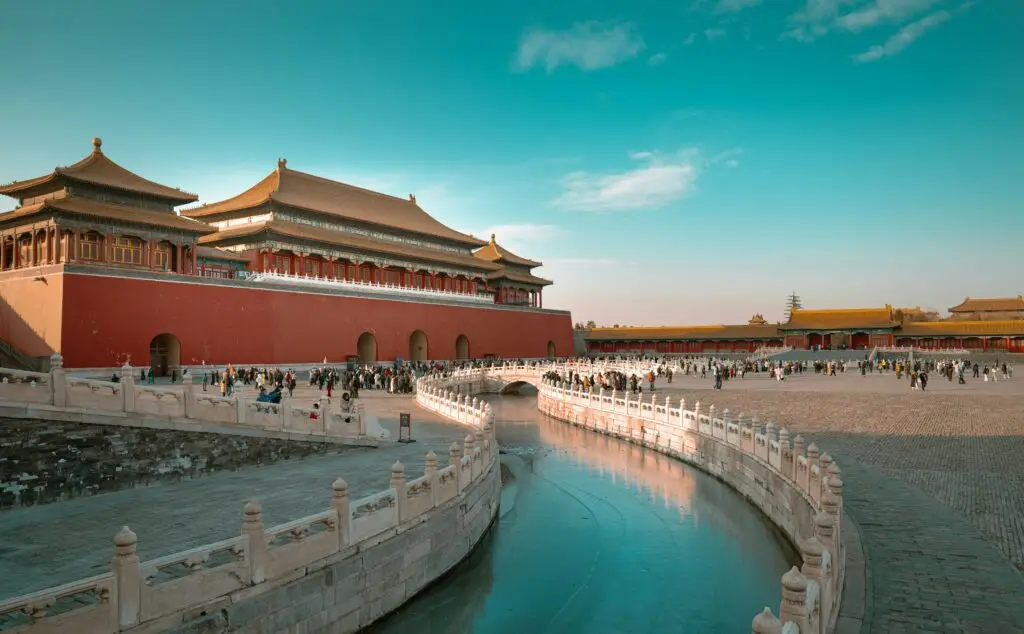Architecture & Heritage Sites in China
Imperial Landmarks
The Forbidden City (Beijing)
Once the political and cultural center of China for nearly 500 years, the Forbidden City is the largest palace complex in the world. Its golden roofs, carved gates, and vast courtyards reflect the grandeur of the Ming and Qing dynasties. Visitors today can wander its halls and gardens, imagining life within walls once reserved for emperors and their courts.
Travel Tip: Go early in the morning to avoid crowds and don’t miss the view from Jingshan Park just behind the palace.The Great Wall of China
Stretching over 21,000 kilometers, the Great Wall remains one of the world’s most iconic feats of engineering. Originally built to protect against invasions, it now offers travelers breathtaking hikes along restored sections like Badaling and Mutianyu, or more rugged adventures at Jinshanling and Jiankou.
Travel Tip: Bring sturdy shoes — the steps are uneven — and consider sunrise or sunset visits for spectacular light.
Gardens & Classical Design
The Classical Gardens of Suzhou (Jiangsu Province)
UNESCO-listed and considered masterpieces of Chinese landscape design, Suzhou’s gardens are a study in harmony. Ponds, rockeries, pavilions, and winding corridors are carefully arranged to create shifting views that resemble living paintings. The Humble Administrator’s Garden and the Lingering Garden are two of the finest examples.
Travel Tip: Visit in spring when flowers are in bloom, or early morning for a quieter experience.Summer Palace (Beijing)
Built as a retreat for emperors, the Summer Palace is an expansive mix of gardens, lakes, and pavilions. The highlight is Kunming Lake, spanned by the 17-Arch Bridge, and Longevity Hill, where palaces rise against the sky. It reflects the Chinese philosophy of blending human construction with nature.
Folk & Communal Architecture
Fujian Tulou (Fujian Province)
Massive circular earthen houses built by the Hakka people, Tulou structures were designed to shelter entire clans, sometimes housing hundreds of people inside. With their fortress-like walls and communal courtyards, they’re both practical and symbolic of shared living.
Travel Tip: Yongding and Nanjing counties have some of the most accessible and photogenic Tulou clusters.Pingyao Ancient City (Shanxi Province)
One of China’s best-preserved ancient towns, Pingyao is surrounded by Ming-dynasty walls and filled with traditional courtyards, temples, and old banks (it was once the financial center of imperial China). Walking through its streets feels like stepping back in time.
Sacred & Religious Sites
Shaolin Monastery (Henan Province)
Known as the birthplace of Chinese Kung Fu and Zen Buddhism, Shaolin Temple combines martial arts legends with spiritual heritage. Monks here still practice kung fu, and performances showcase centuries-old traditions. The surrounding Pagoda Forest is a striking burial site for generations of abbots.Mount Wutai (Shanxi Province)
One of China’s four sacred Buddhist mountains, Mount Wutai is dotted with over 50 monasteries, from colorful wooden temples to massive halls. It has attracted pilgrims for centuries and remains an active center of worship.
Travel Tip: Dress modestly and respect temple customs when visiting.Leshan Giant Buddha (Sichuan Province)
Carved into a cliffside overlooking the confluence of three rivers, the Leshan Buddha is the largest stone Buddha in the world, standing 71 meters tall. Built in the Tang Dynasty, it symbolizes devotion and engineering genius.
Archaeological Wonders
Terracotta Warriors (Xi’an, Shaanxi Province)
Discovered in 1974, the Terracotta Army guards the tomb of Qin Shi Huang, China’s first emperor. Thousands of life-sized soldiers, horses, and chariots — each uniquely crafted — stand in silent formation, offering an unforgettable glimpse into ancient military might.
Travel Tip: Allow at least half a day to explore the museum and excavation pits.Mogao Caves (Dunhuang, Gansu Province)
Also called the “Caves of a Thousand Buddhas,” this site along the Silk Road houses nearly 500 temples with exquisite Buddhist murals and sculptures dating back to the 4th century. It’s one of the world’s greatest collections of Buddhist art.
Travel Tip: Tickets are limited, so book in advance.
Ancient Towns & Villages
Lijiang Old Town (Yunnan Province)
A maze of cobbled streets, canals, and wooden houses, Lijiang is home to the Naxi people and their unique Dongba culture. It’s a charming blend of history and daily life, with music, markets, and mountain views.Hongcun & Xidi (Anhui Province)
Near Yellow Mountain, these UNESCO-listed villages are known for their traditional Anhui architecture — whitewashed walls, black-tiled roofs, and peaceful ponds. They’ve inspired countless artists and were filming locations for the movie Crouching Tiger, Hidden Dragon.
Why These Sites Matter
From the grandeur of Beijing’s palaces to the quiet charm of rural villages, China’s architectural heritage reflects its diversity and depth. These sites are not just tourist stops — they are living museums, places where ancient philosophy, artistry, and community values are still visible today.
Exploring them allows travelers to step into China’s past, while also understanding how history continues to shape its present.

